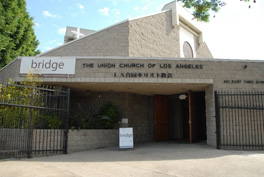Editor's note: This is the latest in a series of stories about congregations responding to the Presbyterian Church (U.S.A.)’s call to “Grow Christ’s Church Deep and Wide.” The call to grow in evangelism, discipleship, servanthood and diversity was adopted by the 2008 General Assembly and renewed by the 2010 General Assembly. — Jerry L. Van Marter
Partnership is always a delicate balance between two sides, but what happens when one side is so large that it could easily swallow up the other?
Bel Air Presbyterian Church in Los Angeles strives to strike that balance with the small Union Church from the city's Little Tokyo neighborhood in a joint effort to reach a new segment of the city.
Los Angeles, as the Rev. Linda Culbertson, general presbyter for the Presbytery of the Pacific, explains, is a bit different from other cities.
"People don't really live downtown in Los Angeles. They live out in the suburbs," she said, adding that this trend has been changing recently thanks to some gentrification efforts. New mixed-use commercial and residential communities in the older downtown areas are bringing in a young, multicultural population.
That new population presents an opportunity for outreach. Culbertson approached the Rev. Enock De Assis, pastor of outreach at Bel Air, with an opportunity for a project for the thriving church, which has nearly 3,000 members. Because of the low population downtown, there aren't many churches there. Culbertson thought that Bel Air might be able to find a site and offer some sort of a church presence.
But Culbertson was not the only one who saw this opportunity. The Rev. Masaya Hibino is interim pastor of Union Church, located in the heart of this new and growing population. Hibino saw the influx of downtown residents as an opportunity for growth.
Union Church, which has served the Japanese-American community for more than 90 years with both Japanese and English language services, has been particularly hard hit by the migration of Los Angeles residents to the suburbs. Combined, the church's two Sunday services typically have 120 people. And not only has the size of the congregation been shrinking, but those who are left are older. For Hibino, reaching out to these new younger residents was a way of insuring the survival of his church.
The effort for the small church seemed daunting, but Hibino recalled hearing the Rev. Mark Brewer, senior pastor of Bel Air, speak of a desire to see churches join together to impact the city. With that in mind, Hibino reached out to Culbertson and De Assis and proposed a partnership.
"He told me they really wanted to do something but they just didn’t have the energy to do it," De Assis said. "They had the site but not the energy."
De Assis understood Hibino’s idea for what they might accomplish together and the two began discussing the partnership.
"It can be delicate working across different cultures, so it had to be approached right," De Assis said.
The outreach, located at Union, was named the Bridge and is meant to appeal to new, non-Japanese residents. Moving forward, more community fellowship events will also be part of the plan. Union and Bel Air are working together to plan worship and events.
Bel Air came up with most of the funding for the project, but Union, wanting to contribute to the effort in every way it could, also provided funds.
Union gave the team freedom to design the style of worship, understanding that the Bridge needed something different from the traditional Japanese service Union offers

Members from Union Church and Bel Air Presbyterian are working together on a new outreach program.
New members coming to the downtown services would be members of Union Church. Members of Union hope that their church will continue to have some Japanese roots going forward, but recognize that the new people coming in to the community are the future of their church.
People are already coming in from the neighborhood to see what the Bridge is all about, although De Assis points out that the effort is still in a team building phase that was planned for the first year.
Bel Air has sent 25 members and Union has a group as well that will help launch the program. A pastor has been hired and is doing training with the members to teach them how to work with newcomers. Once that training is complete, the focus will move more toward the outreach into the community.
One big concern was the difference in the sizes of Union and Bel Air. Although Hibino and the members of Union wanted the help of a large church with energy and resources, there was some fear they would be consumed and taken over by their large partner.
"The teams worked hard to make sure one church didn't overshadow the other. Both show their strengths," De Assis says.
One of Union's big strengths lies in hospitality. The welcome and reception team for the Bridge service is made up mostly of the Japanese members.
To help keep balance, the presbytery has also been asked to help work out the partnership. Both churches trust Culbertson.
"It's important that Bel Air and Union people both know we're not there to take over," De Assis said. "We always talk about the Bridge as a partnership with the Union Church to indicate to the congregation that it's us coming in alongside others.
"It's always harder to do something in partnership because it takes time to understand one another and sometimes say no to what you want to do right now in order to take time to listen to the words of a partner," he said. "Partnership is the way we listen to the voice of the spirit through the voice of others as we are working together."
Toni Montgomery is a freelance writer in Statesville, N.C., where she is also secretary for First Presbyterian Church.

